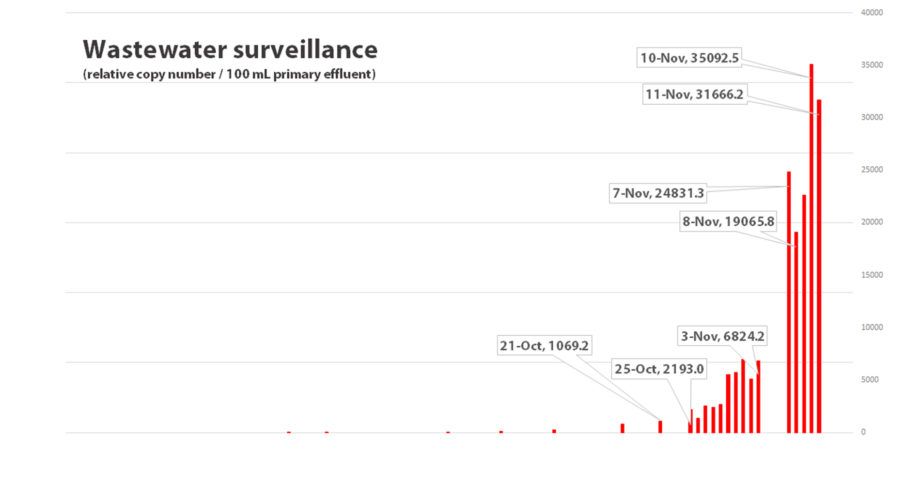Data collected by the University of Saskatchewan’s (USask) wastewater surveillance team shows that the number of COVID-19 cases in Saskatoon are likely to increase exponentially in the next seven days.
“Numbers of copies of SARS-CoV-2 viral RNA in the wastewater have been climbing,” said USask toxicologist Markus Brinkmann. “We expect another drastic increase this week and potentially ranging into next week.”
Infected people shed virus traces through their feces, often even before COVID-19 symptoms are apparent. Changes to virus amount in wastewater precede changes in case counts at COVID testing centres by about one week.
The wastewater surveillance approach tracks the rate of change in COVID-19 spread on a population basis, not individual cases. However, based on the slope of the curve of rising case numbers, the team can extrapolate from the wastewater data to predict the impact on the case count.
“We are expecting an average of 100 to 150 new cases in Saskatoon each day,” said Brinkmann. “With no significant changes in transmission, this trend can be expected to continue.”
In the most recent reporting period that ended on November 15, 2020, the amount of virus in the wastewater sampling increased 2.5 times over the previous week.

The early warning approach, developed by USask researchers and partners at the City of Saskatoon (CoS) and the Saskatchewan Health Authority (SHA), tracks the total amount of SARS-CoV-2 virus circulating in the city’s wastewater through lab analysis of samples from Saskatoon’s municipal treatment plant.
“This approach certainly does seem to demonstrate predictive value,” said Dr. Cory Neudorf, a USask professor of community health and epidemiology and consulting medical health officer with the SHA. “It’s another piece of evidence that gives early warning to the system about potential surges in COVID-19 cases.”
While university researchers also provide computer modelling predictions, Neudorf said that wastewater approach can assist with pandemic response policy and planning.
“This data can provide an early warning that testing capacity could be stretched further in the coming week,” said Neudorf. “And if we know that case numbers are likely to go up, we know that a week or two after that, hospitalization rates and ICU admissions will go up. The net impact is that this helps in deciding on whether further restrictions in polices are needed now in anticipation of those increases, so that the pandemic doesn’t get ever more out of control.”

The research team is gathering samples and processing data five times per week—an increase from October 2020 when the researchers gathered data once per week. Team leader John Giesy is hopeful the pilot project—funded by the USask-led Global Water Futures program and supported by in-kind contributions from the CoS—can be continued beyond November 2020, provided that funding can be found.
Giesy noted that people who show up at COVID-19 testing stations are usually those with symptoms or suspected COVID exposure, which misses most of the so-called asymptomatic or pre-symptomatic cases. And as the most accurate nasal swab is collected 48 hours after the onset of symptoms and testing is not instant, positive test results show the past, not the present.
“Our data provide advance warning, whereas approaches based on individual testing data are retrospective,” said Giesy.
The team’s wastewater surveillance approach is based on a method for measuring SARS-CoV-2 virus environmental degradation developed by Giesy and Yuwei Xie. Working with USask engineering researcher Kerry McPhedran, the team has adapted the method to capture COVID-19 information. Engineering graduate student Shahab Minaei and his supervisor Jafar Soltan are also part of the team.
The USask approach has been validated by reliability testing organized by the Canadian Water Network. Laboratories across Canada compared different methods of analysis, and found the USask-developed method was accurate in detecting the virus at different concentrations.
Research into wastewater surveillance is underway in several places in the world. The USask method is also being used by institutions in Ontario, Texas, and China.










Can anyone at your business advise us how long (hours/days more) Covid-19 remains active in sewage and if we are drinking this as tap water?
thank you
Many rural communities in Canada are sourcing their drinking water from rivers where xommunities upstream are dumping their wastewater. New water treatment plants cannot filter many toxins and chemicals as they are not designed for that (and the cheaper option is most often preferred). Jim’s question is a critical one.
And, then, what happens when COVID-19 beomes distributed into the environment and wildlife? More mutations? A vaccine would be useless then.
Seems to me that the most important lesson that COVID is teaching us when it comes to the way in which we treat water — (water IS LIFE) is that taking water from a river to drink and then dumping our wastewater into it for some other community to treat and drink and then they dump their waster into the river and so on and so on added to the agricultural chemicals flowing off the land, execess nutrients. endocrine disruptors, antibiotics and resistant bacteria and pathogens from intensive livestock production (for the sake of profits of exporting multinational corporations), oil and mining pollutants, plastics, pharmaceutical residues, contaminants from cottage developments and on and on are weakening ecosystem resilience and setting us up for more disease,
Our complete and utter disrespect as a species for the web-of-life and life-giving WATER is going to be as much our demise as climate change and pandemics such as COVID. We have had predictive capacity about the consequences of mistreating water for a long time. We just don’t listen because the “economy” is most important. What a misguided priority. It continues to amaze me that with the COVID crisis people still don’t get it that nature bats last. We all need to change the game so that we can continue to be in the game with the other species we share this planet with.